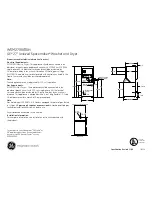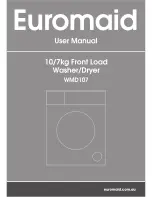
5
To save energy
Place dishes in the machine immediately after every meal and
wait until the dishwasher is full before washing.
If necessary run the Rinse and Hold programme (see
"Washing Programmes" chart) so that any food scraps do not
become caked on the dishes while you are waiting to run the
complete wash programme.
Do not prewash dishes under running water.
Select an economic programme when dishes are not very
soiled, following the instructions given in the "Washing
programmes" chart.
For best washing results
Before loading, remove all scraps of food and soak very
heavily soiled pots and pans.
Arrange saucepans, cups and glasses etc. upside-down.
Tilt items with convex or concave surfaces so that the water
drains off easily.
Avoid contact between the dishes as far as possible.
Items not suitable for dishwashers
The following items should not be washed in the
dishwasher (unless they are sold as dishwasher proof):
-
Cutlery with wooden or horn handles or glued parts
-
bronze cutlery
-
saucepans with wooden handles
-
aluminium ware
-
crystal ware
-
leaded glass
-
plastic items
-
antique or fine decorated china
Certain types of decoration can discolour when washed in a
dishwasher.
Crystal-ware and plastic objects, if not guaranteed dishwasher
proof should be washed by hand.
Certain types of glass can also become opaque
after being washed several times in a dishwasher.
A chemical reaction can occur between silver cutlery and
stainless steel cutlery. As a precaution, do not wash together.
Iron and cast iron objects can rust and stain other items.
Aluminium tends to go black, copper, pewter and
brass tend to stain.
If in doubt check with manufacturer of the item.
When buying new dishes, ensure that they are dishwasher
proof.
Hints and tips
Before using your dishwasher for the
first time
1. Ensure that the electrical and water connections
comply with the installation instructions
2. Remove all packaging from inside the appliance
3. Fill the rinse aid dispenser.
Rinse aid
Rinse aid is automatically added during the last rinse, ensuring
thorough rinsing, spot and streak free drying. The dispenser,
which is positioned inside the door, holds about 110 ml of rinse
aid, which is sufficient for 16 - 40 dishwashing programmes,
depending upon the dosage setting.
Filling with rinse aid
1. Open the container by turning the lid (A) anticlockwise.
2. Add the rinse aid until the container is completely full.
The indicator (B) will be completely dark.
3. Top up the rinse aid when the indicator (B) becomes clear.
Ensure that the lid is closed after every refill.
Do not put liquid detergent in the rinse aid compartment. Clean
up any rinse aid spilt during filling with an absorbent cloth to
avoid excess foaming during the next wash.
Adjusting the dose
According to the finish and drying results obtained, adjust the
dose of rinse aid by means of the 6 position selector (C)
(position 1 minimum dosage, position 6 maximum dosage).
Increase the dose if there are drops of water or lime spots on
the dishes after washing. Reduce it if there are sticky whitish
streaks on the dishes.
BR01
BR03
BR02
Summary of Contents for BIDW 651
Page 1: ...Instructions for the use and care of your BIDW 651 Dishwasher...
Page 14: ......
Page 15: ......


































